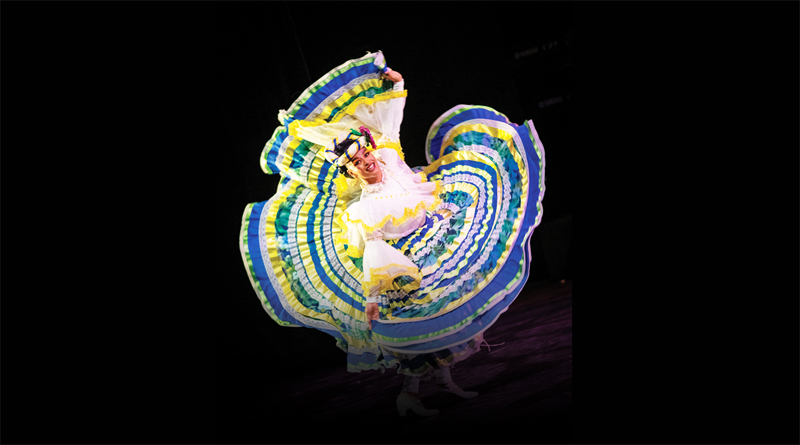

In under two hours those in the Royal Opera, House of Musical Arts were taken on a whistle-stop tour of Latin America through music, song and dance. To round off the long weekend on Sunday evening, the ‘Banda Monumental de México’ with the ‘Tenochtitlan de Puebla Mexico’ Folk Music Company, provided a whirl of colour, Latin rhythms and haunting ballads in a spectacular performance, which took away the breath of everyone watching. The eclectic, flamboyant show was one of the most visually stunning experienced at ROHM and featured an amazing display of dances from across Latin America.




Bang on time the thirty-three musicians clad in white filed on stage under the banner, ‘Banda Monumental de México’. Hot from their appearance in the Military Music: Oman and the World tattoo in the Maidan last week, a troupe of tribal Aztec warriors in Apache headdresses burst on, roaring and shrieking to a solo drum rhythm. There was a lot of cheering and whistling throughout the show, adding to the exuberance and sheer joy of performance, for dancers as well as audience.
In complete contrast a folk dance from Peru, ‘Machu Pichu’ involved the four singers in a rough, colloquial song, ‘Huamanqueño’ to steel-pan accompaniment and dancers in perfect synchronisation. ‘Mexican Revolution’ was a feisty, Macchiato dance with another troupe of eight ladies in whirling coloured skirts followed by men with guns to a rousing brass backing, conveying their tremendous energy and infectious joy in every twist and turn. As they ran off to a fine brass fanfare, another team of eight ladies in flamenco-influenced costumes hurtled on stage, shouting and yelping to a chorus of saxophones in a Latin Big Band sound of Columbia’s, ‘Colorada’.
The 1932 standard, ‘Granada’ by Mexican composer Agustin Lara is the signature song of José Carreras and favourite of Pavarotti and Domingo, but in Muscat it was performed by the velvet voice of Julian Salvador Sorcia Soto and embellished with the first trumpet solo from Kenny Arafat Sorcia Alarcon whose technique is as exotic as his name. Second trumpet soloist, Alain Jefersson Sorcia Alarcon joined him along with bass guitar and guiro effects.
The final three numbers of Part One were all from Mexico, featuring folk tales as narrative dances, such as the flirtatious handkerchief dance, ‘Guerrero’, with tenor saxophone solo from Seth Flores Vidal. The very dramatic, tango-like, ‘Sinaloa’ with high trumpet solo was performed by four couples in macchiato costumes in a swirling mass of colour where everyone was clearly having a great time. The smooth Ballad, ‘México Lindo’ was a popular rumba, also seen in the Military tattoo, as eight girls in green dresses danced with men in red ponchos, hats in hand, demonstrating fine footwork to changing tempi in a flourishing first Finale.
Part Two moved towards a more contemporary style of choreography (Vicente Huerta Vazquez), with meticulous timing and professional attention to detail in every sense. Whisked off to Cuba, ‘Guantanamera’ was danced by a solo couple in white to a Conga solo from Victor Manuel Cruz Sanchez. As the full complement joined them, modern dance steps became expressively acrobatic, with scenes of the sea and bicycles enacted. The iconic and ever popular, ‘Quizás, Quizás’ was sung in the sultry, beguiling tones of Julian Salvador Sorcia Soto, contrasting with Concepcion’s raunchy and husky quality. The lady dancers in green and black, like nimble ballet students, performed a Broadway chorus line to a Big Band backing.
A highlight came with the Tango Argentina, ‘Por Una Cabeza’ danced sensuously by a couple in black to a long seductive tenor sax solo, unfortunately doubled by a less than tuneful fiddle. It was followed by ‘La Bruja’ (witchcraft) from Veracruz, waltzed by eight ladies in white dresses and eerie face masks to trumpet solos and the whole ensemble. An effervescent ‘Merengue’ from the Dominican Republic was a fast, lively song with orchestra ablaze, ladies in white with trim like enthusiastic cheerleaders, while the men were radiant in sparkly blue jackets. It was a modern interpretation of traditional dances and costumes, with strong gestures and dance technique.
The much loved chestnut, ‘Bésame Mucho’ was performed with feeling and heart-felt expression by Salvador, trumpet solo and full backing. Demetrio and Beltrán’s 1953 ‘Quién Sera’ (‘Sway’ by Julio Iglesias) was also beautifully sung, while the men in pink satin showed some impressive footwork. Hotly pursued by a new octet in purple and black, a Broadway routine was effective against slinky seductive brass playing and a brilliant high trumpet solo from Kenny Arafat.
The ‘Mambo’ Finale was worthy of Bernstein. Eight boys in red and black costumes showed tremendous energy as they twirled their partners in a carnival atmosphere. It led to a grand curtain call, the popular Puerto Rican hit, ‘Despacito’, as the cast of forty eight danced into the auditorium with South American flags in traditional and Macchiato costumes. There were just smiles and accolades as people left — but what a pity this extravagant spectacle was for one night only. Maybe they will return for the Oman World Folk Music Festival in January for more people to enjoy.
PHOTOS BY KHALID AL BUSAIDI
Oman Observer is now on the WhatsApp channel. Click here



